1. One structure
The Creation account (G1:1-2:4) conspicuously conveys meaning using the literary shape of the text. The narrative is told with formulaic patterns, repetitions, and parallelism. The Garden account is different. It is viewed as a separate text, with its own author, employing its own structure. This second account’s structure is looser and unrelated to the first. For organizational purposes, this paper refers to the material from G2:4 – 6 as GARDEN.
The structuring elements of CREATION are days. The first six days divide between two panels. Corresponding elements in the two panels are related. Habitats are formed in the first panel, those habitats are filled with suitable creatures in the second. The third element in each panel has a second creative act. Figure 1 shows an abstract representation of this structure.
The structuring elements of GARDEN are less evident. This paper identifies structuring elements for GARDEN that yield for it a congruent shape to that of CREATION. This suggests that these two stories about beginnings are well-designed separate halves of a single beginning story. These structural elements in GARDEN arrange into the recognized three-part forming and filling panels that is used in the CREATION text.
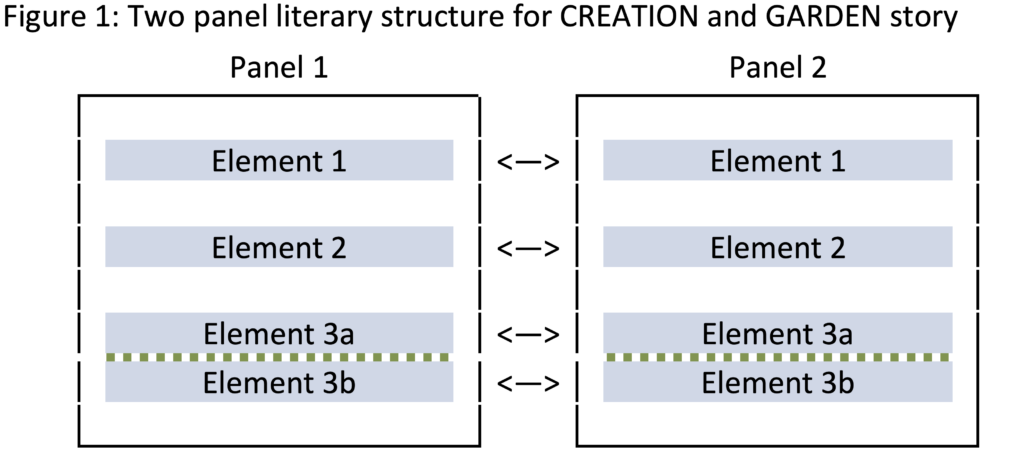
2. Design
CREATION and GARDEN give different accounts of the world’s beginnings using details drawn from opposite ends of a number of spectrums.
- CREATION describes God using his word to separate and call forth a hospitable land from a chaotic sea. GARDEN describes a river of living water gushing from a sterile and featureless plain, without plant or bush.
- God’s word is irresistible during CREATION, in GARDEN God’s word is questioned and disobeyed.
- Humanity is made in the image and likeness of the transcendent God at CREATION, in GARDEN man is made from the dirt.
This paper seeks to demonstrate that the two episodes are tightly coupled by parallel links between a shared literary structure. Each story is composed of two panels. The first panel describes a forming, the second a filling. Each panel has three members. The first and second member have one act, but the third members have two. The three members in the two panels parallel each other, the respective members correspond. A further seventh member stands outside the two panels, it will be discussed last.
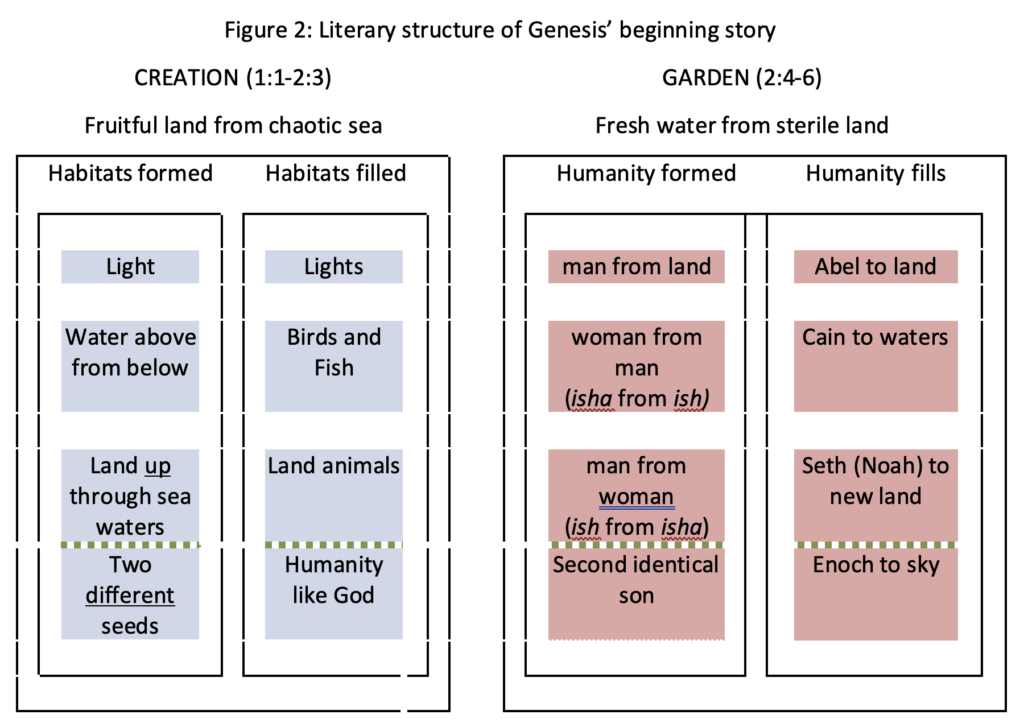
The GARDEN story recycles the CREATION story’s structure. This becomes evident once the correct structuring elements is applied. The movements and actions in the GARDEN members will correspond to parallel members in the CREATION structure. The correspondence is sometimes direct, but more often the GARDEN element inverts some aspect of its corresponding CREATION member. The remainder of this paper explores these correspondences.
3. The Acts: Forming and Filling
3.1 Forming
In the first panel of CREATION God creates distinctions that lead to habitats. Each distinction is enacted by divine fiat. These creative acts are itemized in the first panel of Figure 3.
In the GARDEN’s first panel, there are four different processes that each lead to a new human life. These processes parallel the creative acts in the first panel of CREATION. These four processes each have a common feature with the acts of creation on the first three days of CREATION . Each formation in the GARDEN account also inverts a detail from the corresponding day of CREATION.
Figure 3 aligns the first panel from both the CREATION and GARDEN accounts. Some notes regarding the relationship between the corresponding elements:
- The first elements of the two panels contains something drawn from the dark. At CREATION light is called from the dark, in GARDEN the man is drawn from the ground. The two dark origins, sky and ground, are opposite each other; one is above, the other below. Light, seems to be created ex-nihlio, while the next two creative acts are drawn from existing substances. Similarly, the manis drawn from the dirt, the other two human formations (division and birth) are drawn from an existing human.
- The second element of formation in CREATION and GARDEN both part a single body into two separate bodies of the same substance. At CREATION the water above is drawn from the water below. In GARDEN the woman is separated from the man’s side. The separation at CREATION is vertical, above and below, while the separation in GARDEN is horizontal, they are described as being k-negdo(כנגדו), opposite each other(G2:18).
- The third member in the formation panels in both accounts is drawn through water. Land is drawn up through the waters at CREATION. In the ancient Middle East, the woman squatted while giving birth. The babe emerged through waters from laboring the woman above. The waters in this case is the amniotic fluid that brakes upon labor.
- The second creative act of the third day in the first CREATION panel describes two types of seed. In GARDEN, the third member has two parts as well. The next human creation process is twinning. The twin son is Abel. The narrative describes one conception but two births(G4:1), meaning that Abel is a twin. Corresponding to CREATION, Cain and Abel are different seed, yet identical (twin) seed.
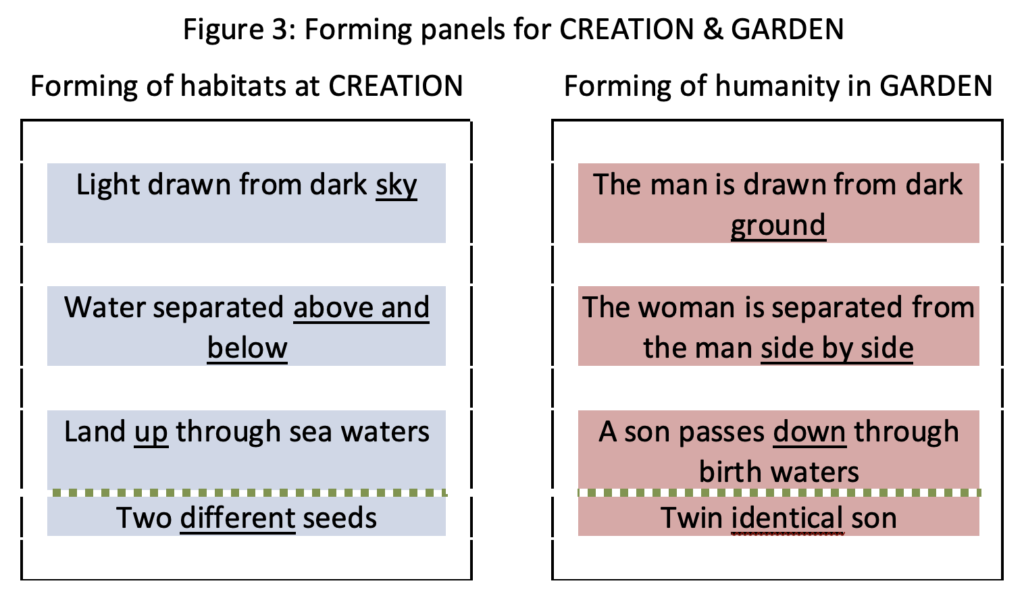
3.2 Filling
At CREATION the structuring elements in its second panel are the creatures that fill the habitats formed in the first panel. The habitats formed in the first panel, (heavens, sky, sea, and land) are filled with suitable creatures in the second, see Figure 4.

GARDEN is similar. In its second panel, the literary elements describe how the sons of the first man and woman fill (or don’t fill) the earth. The fates of the sons or the lines proceeding from them is described. The sequence of the elements does not follow the order in which the sons are introduced, rather the order is determined by the textual order in which the fates of the sons are described.
Though Abel is the fourth human described earlier, his fate is described first in the text. Then the narrative turns toward the line of Cain, then Seth. This panel includes a fourth fate for the progeny of humanity described by Enoch. Each fate is connected to one of the realms of land, sea, sky, or heavens much as the creatures in CREATION fill these realms.
The elements of the second GARDEN panel correspond with elements in the second panels of CREATION. The relationship between corresponding elements has the same quality of similarities and inversions found between the first panels. These relationships are shown in Figure 5.
- The stars and lights in the heavens are known by their persistence and dependability to mark seasons and times, Abel’s quick exit without a single word focuses on his ephemeralness. His name, Abel, essentially means ephemeral.
- The next element in the second CREATION panel describes the life that swarms in the separated waters. After Abel’s death, the GARDEN narrative recounts Cains’ line filling the earth. CREATION describes life in the waters above and below. GARDEN describes Cain’s line who drowns in the flood when the waters above and below collapse into each other.
- The third element of the filling panel of CREATION describes the animals that live on the emerged land. The GARDEN describes the birth of Seth and the generations leading to Noah. Noah preserves humanity by crossing the flood in an ark to a new land that emerges when the flood waters subside.
- The second part of the third element in the second panel of CREATION describes the creation of humanity. the single creature made in the image and likeness of God. The corresponding member in GARDEN describe Enoch, the single human who is prematurely taken to walk with God.
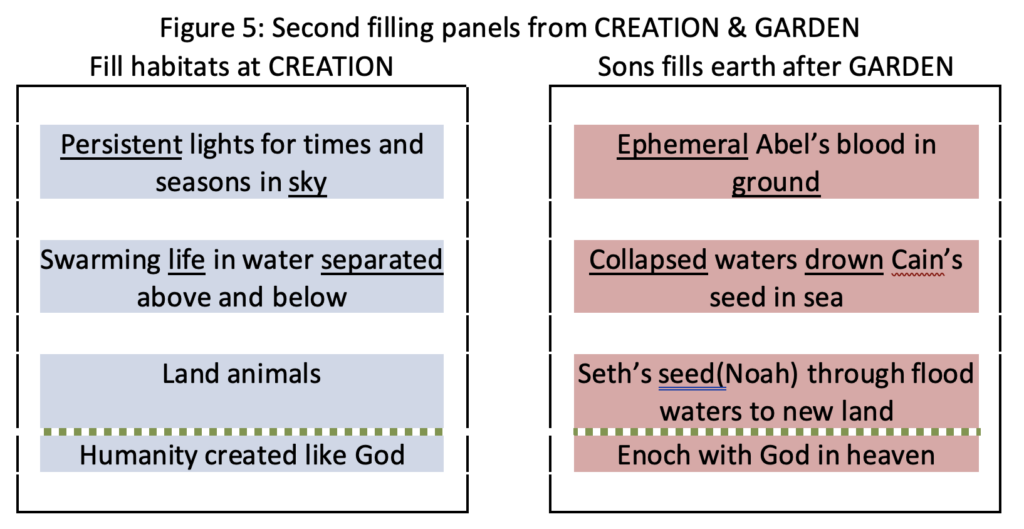
The first and second GARDEN panels are related in a similar way as the two CREATION panels. However, the relationship often has the characteristic inversions found between the other panel comparisons that is examined above. These inversions in the filling second-panel typically indicate a reversal of the initial forming acts of the first panel.
- The first living man is drawn from the dirt in the first panel, while the blood of the first dying man is swallowed by the dirt. Both accounts have a play on words. Adam, meaning man, is cognate with the word for dirt adamah. Similarly the word for blood (dam) is cognate with both these terms. First the adam/man emerges from the adamah/ground, later the adamah swallows the dam/blood of man.
- Woman is separated from man in the first panel, the creative act involves a single whole that is halved. The fate of Cain’s line is that both man and woman drown when the single body of water that was separated, above and below, collapses to cause the flood.
- Cain emerges alive through the birth waters in the first panel. The descendants of Seth, as realized in Noah and his family, come through the waters, birthed into a new world in the second panel.
- The extra acts in the third elements have an interesting correspondence. Ephemeral Abel is born in the first panel, Enoch is taken by God, into the heavens. Both are taken prematurely, neither says a word.
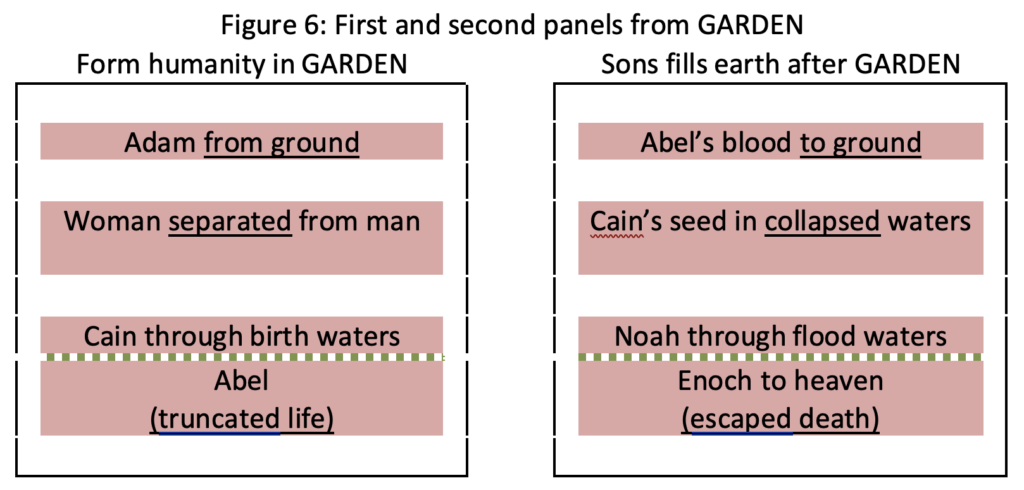
Notice that the first two elements of the first panel, the formations of man and woman are formed by God, while the two formations in the third element Cain and Abel are born by humanity. Abel and Cain and Abel’s line terminate in the ground and water in the first two elements of the second panel, while Noah and Enoch in the third element persist in new land and heaven.
4. Seventh element
The CREATION week ends with a seventh day of rest. The seventh day is part of the CREATION narrative but it stands outside the two panels. A corresponding single element in the GARDEN narrative is not evident. However, the seventh members of the two lines of descendants from Adam appear to have corresponding content.
Enoch, the seventh member of the line of descendants between Adam and Noah walks with God. His 365 years suggests completeness. Meanwhile the seventh in line descendants from Adam through Cain invokes a 77x vengeance. This call for vengeance occurs soon after reading about the labors of Lamech’s sons.
Consonant with the earlier relationships between panels, there is an element of both similarity and inversion with these seventh members. Enoch rests in completion with God, while Lamech agitates, multiplies violence and toils.
5. Conclusion
Meaning is encoded in both words and structure. Design evidences itself through deliberate word choice, but also word order, echo, allusion, rhyme, pun, etc. Source critics have looked to different vocabulary and concluded that the CREATION and GARDEN episodes emerged from different communities that wrote at different times. The biblical text fails to yield its richness when viewed with this simple lens.
It is evident to the casual reader that CREATION and GARDEN are intertextually rich. The structural insights in this paper provide the Bible student a lens to verify this intuition. After identifying the proper structuring devices of the text, the relationship between the texts becomes evident and familiar.
The similar structure of CREATION and GARDEN allows the student to draw further meaning from the text. Corresponding elements can be inspected for their similarities and differences. This triggers the student to ponder the similarity of corresponding members. In what ways are the drawing of light from the dark sky and man from the dark earth similar? We can better see the same fingerprint of the one who separates water above-and-below, and also makes man and woman side-by-side. Ultimately, the student can confirm their intuition that the first two episodes of scripture form a coherent whole, and not a clumsy collection of heavily redacted sources as some suggest. This confirmation will lead to confidence in the text, trust in its authority, and faith in its author.
Scott Fairbanks is a student of scripture. He lives in Corvallis, OR with his wife and three children. He has begun maintaining a website to contain his observations on scripture at Lotech Wonders.
